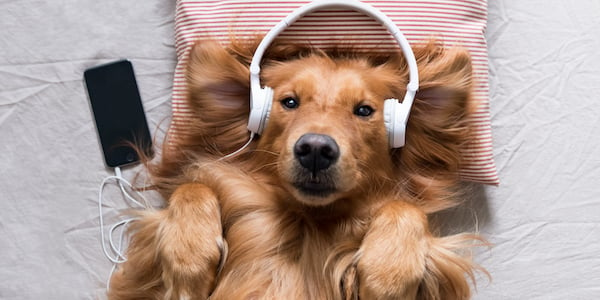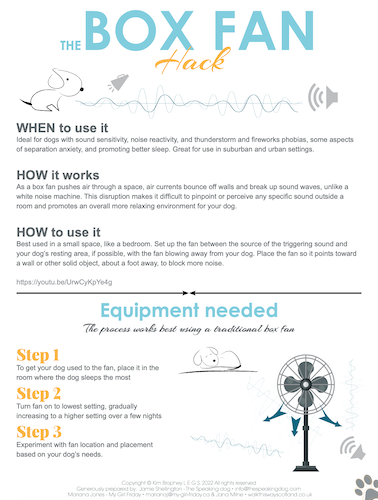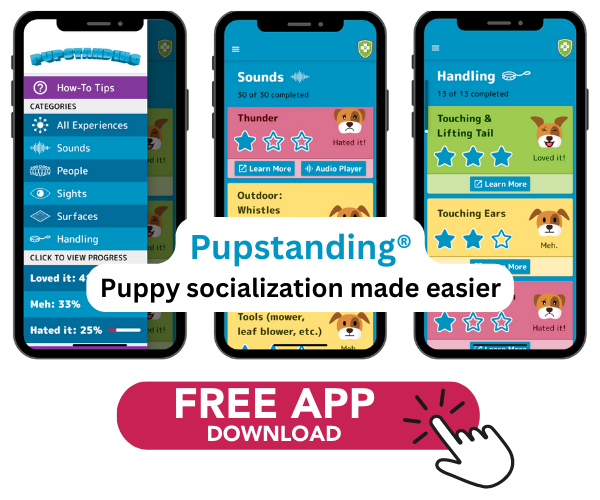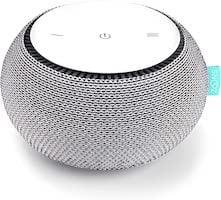 Does your dog get scared during thunderstorms or fireworks? Do they suffer from separation anxiety? Or do noises outside make them bark nonstop? Turning on some music or some form of white noise for your dog can help relieve their stress and reduce barking.
Does your dog get scared during thunderstorms or fireworks? Do they suffer from separation anxiety? Or do noises outside make them bark nonstop? Turning on some music or some form of white noise for your dog can help relieve their stress and reduce barking.
Recent studies have shown that playing music reduces stress in dogs at animal shelters, with less barking, lower respiratory rates, and lower levels of the stress hormone cortisol.
This shouldn’t come as too much of a surprise, as the effect music has on human emotions has been a subject of study for quite some time. Music therapy is used as a natural anti-anxiety remedy and to help with sleep disorders, and it’s easy to use the same technique for your puppy or adult dog.
Table of Contents
What Kind of Music is Calming for Dogs?
You can use music to help your dog feel calmer and encourage relaxation — but wait! Certain music genres have been proven to be more soothing for your dog than others. Reggae and soft rock are the most relaxing music for dogs in shelters, and classical music also helps calm down dogs in stressful environments. So if you're getting tired of another Mozart symphony, turn on some Bob Marley. Other studies have shown that harp and piano music can also be quite calming.
Variety within the genres mentioned above seems to be the most effective for anxiety and stress relief. After about 7 days of the same kind of music, dogs get used to the background noise and begin to show more stress. Mix up which stations you leave on for your dog, letting your dog enjoy some Desmond Dekker, Fleetwood Mac, and Mozart. You might even consider throwing an audio book into the rotation every so often to mix it up.
Just as some music promotes calm, certain genres have the opposite effect when tested on dogs in shelters. Avoid heavy metal music or other songs that have loud booms or discordant sounds.
Follow Preventive Vet on Spotify for different pet-centric playlists. Here's a Soft Rock for Dogs playlist of our favorite mix of songs to help de-stress your pet:
There is even music composed specifically for dogs, whether it’s for generally anxious dogs, those with separation anxiety, fear of thunder, or for helping a new puppy sleep through the night. Watch how music artist Gnash wrote and recorded a song for his anxious dog Daisy:
YouTube also offers many different options for calming dog music, ranging from an hour to 8+ hours long. Dogs might have different preferences but the length of the musical notes, simplicity of tones, regular rhythms, and the music’s tempo are the most important calming qualities.
More products are popping up that include calming music to reduce anxiety. The Calmz Anxiety Relief System is one such product, which claims to deliver acoustic and vibration therapy to reduce anxiety in dogs.
If you want to try products like this one, make sure you're introducing the wearable speaker properly and watching your dog for any signs of stress caused by the vibration of the product. Reviews of the Calmz indicate mixed success. In some reviews, dog owners reported that their dog became more anxious due to the vibration mechanism, the music was too loud for their dog, or the harness didn't fit well.
When trying a new treatment for anxiety, always consider whether there is any possibility it could inadvertently make your dog more anxious.
It's best to work with a veterinary behaviorist, certified dog trainer, or behavior consultant to determine what products will work best for you and your dog.
Calming Music for Senior Dogs
Unfortunately, hearing loss is a normal part of the aging process. With age, a dog can become more sensitive to certain frequencies of sound (middle and high-pitched frequencies) as the nerves in their ears degenerate.
High-pitched sounds may startle your senior dog and continuous exposure can cause stress and anxiety, which in turn affects their immune system and can exacerbate chronic pain — the last thing we want for a senior dog!

To help calm your senior dog and provide a respite from sounds that may hurt their ears, put on music that is lower pitched and doesn't have high-frequency sounds (such as high notes on a piano or flute).
ICalmPet has created a soundtrack specifically for senior dogs and their hearing sensitivity, called Elderly Canine.
You may also consider using a sound machine instead of music to create white noise for an older dog. This can give their nervous system a break after being in highly stimulating environments.
Combine Music with Calming Visual Enrichment
Television and videos for dogs are becoming more popular. Not only can these provide extra enrichment when you're working from home, but they are ideal for when your dog is home alone.
I leave on DogTV for my dogs whenever I leave for a few hours, and I like how I can choose between on-demand videos with calming background music or turn on their live channel. Colors and sounds are chosen specifically for dogs, so you may notice that blues and yellows are more prevalent on-screen.
If your dog barks at animals they see on screen or to the sound of animals or doorbells, then be careful about what programming you choose. The goal is to give them a visual and audio experience that encourages calm relaxation, not that increases barking or reactivity.

When to Play Calming Music for Your Dog
Your dog can benefit from music in a variety of situations, including:
- During the adjustment period after you first bring home a new puppy or dog.
- Whenever you leave your dog home alone.*
- When your dog spends time in their crate, puppy zone, or in their safe space.
- During thunderstorms or fireworks.
- Helping a restless puppy or dog fall asleep.
- At the veterinary clinic during exams.
- While riding in the car to help ease travel anxiety.
Your dog's hearing is super sensitive. Keep the music volume low, just barely loud enough for you to hear. That level is more than enough for your dog.
Pro Tip: If you are planning on leaving music on for a dog that suffers from separation anxiety, you want to make sure you also play it at other times when you are home. You don’t want your dog to learn that when you turn on the music it means you’re leaving, adding another stressful trigger to their anxiety.

Using Music to Help Prevent Barking
If your dog barks at any noise they hear outside, you can play music to help mask the sounds. It’s normal for dogs to alert bark when they hear something outside, and noise masking can be a great management tool. I tend to turn on music or DogTV when I'm working from home, which helps me concentrate as well as keep my dogs from barking.
Using White Noise to Stop Barking
In some cases, music just isn't the best option for calming your dog down, such as when you're also trying to fall asleep. Most people don't want music playing all night long. And music sometimes isn't loud or continuous enough to mask outside noises that cause barking.
Masking ambient sounds can lessen the amount of barking your dog does while alone or at nighttime — something you (and your neighbors) will appreciate. I personally use the Snooz sound machine to mask nighttime outdoor noises that cause my younger dog to bark. It's an all-natural fan, with adjustable volume and pitch depending on what you prefer.
Place the sound machine between your dog and where the noise is likely to come from, such as a window or doorway. This worked extremely well for me when I lived near a busy highway, particularly masking the sound of loud semitrucks passing by. I also use the travel SNOOZ while at conferences, and it's perfect to block the sound of other hotel guests in the hallway outside my room – especially important if travelling with your dog.
Another way to use white noise is to use a box fan. You may already have one at home. Not only does it provide background white noise, but the air current also breaks up sound waves. The Box Fan Hack, created by Kim Brophey, is an excellent way to encourage relaxation at night or when your dog is left alone.
 Click here to download the Box Fan Hack PDF
Click here to download the Box Fan Hack PDF
Using Music to Help Your Dog Get Used to Scary Sounds
For dogs that already get anxious or are fearful of certain noises like thunder or fireworks, you'll want to work with a certified dog trainer to start a desensitization and counterconditioning plan. You can read the basics of this training technique in our Getting Your Dog Ready for Fireworks article.
For puppies and dogs who haven't yet shown anxiety or fear of loud noises, it's worth it to introduce noises in a positive way to prevent noise phobia or anxiety from developing.
- Proactive and positive socialization is the best way to prevent fear and anxiety later in life. While most effective during your puppy's imprint period (between 7 to 16 weeks of age), it can still be done at any age.
- Check out our Proactive Exposure Training Resource Page for videos showing you how to properly socialize your puppy.
- Download our FREE Pupstanding App to keep track of your dog's progress and access a variety of sound recordings to use during socialization practice.

- Check out our Proactive Exposure Training Resource Page for videos showing you how to properly socialize your puppy.
- Dog trainer Victoria Stilwell partnered with Through a Dog's Ear to create audio tracks that combine calming music with low-volume sound effects like fireworks, thunderstorms, and city sounds. These are great tools to introduce a puppy to new sounds in a positive way or use in a desensitization training plan.
- The Sound Proof Puppy App is another great way to proactively expose your puppy to new sounds during their socialization period. It's available on the Apple App Store and on Google Play.
Let us know what music you play to de-stress your pet (or yourself) in the comments below!





